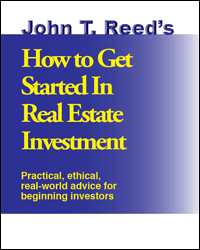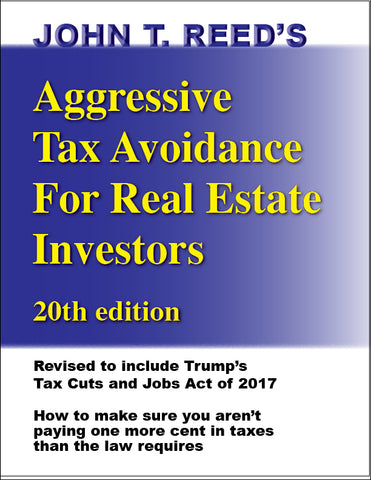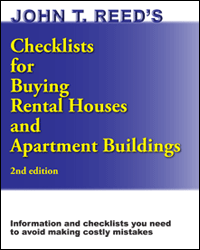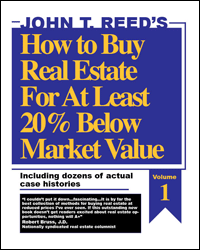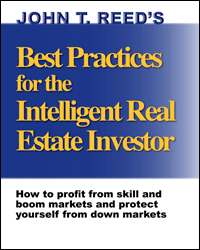
Best Practices for the Intelligent Real Estate Investor
The nature of this book is such that merely reading the following Web description of the book will make you a better investor with better understanding of the real estate investment process.
Here is another similar book I wrote about the big picture of real estate investment. When you buy 2 books at the same time, you save $2.55 on shipping to U.S. addresses. Shipping is free if you buy 3 or more books at the same time.
How to profit from skill and boom markets and protect yourself in down markets
After writing 22 different real estate investment books (64 real estate books if you count editions) and over 5,000 real estate investment articles over 33 years, I finally felt qualified to write a book on the fundamentals of real estate investment. The two missing links were 1. explaining the difference between what the rent and expenses said the buildings were worth and what they were actually selling for in the real world—and 2. managing risk. Two new fields—behavioral finance and financial engineering—came into being in recent years and provided understanding of those two important parts of real estate investing.
Speech by John T. Reed at real estate investors meeting
Here's a montage of clips and sound bites from my speech on this book. I was only able to talk about the first few chapters, but here's a peek at some of the topics covered in the book and my general approach towards real estate investment.
See more of my videos hereSophisticated fundamentals
But not too simple
Make everything as simple as possible, but no simpler.
Sorry, but real estate investment is complex
Real estate investment is complex. Sorry. It's not my fault. That's just the way it is. You need to know that. Throughout my career as a real estate investment writer, I have told readers what they need to know, in spite of the fact that it is often not what they want to hear. The criminal get-rich-quick gurus will say real estate investment is simple because their main goal is to part you from your money. My main goal is to help you make as much as possible.
22 legal specialties
Think about it. Real estate investment involves 22 legal specialties: federal income tax law, state income tax law, state tort law, federal laws pertinent to real estate, securities laws (possibly), bankruptcy planning, estate planning, pension planning, elder law, college financial aid law, landlord-tenant law, partnership law (possibly), trust law with some entities, divorce or family law, foreign law if your entity will be created in a foreign country like the Cayman Islands, HUD law, business law, construction law (possibly), criminal law (possibly), environmental law, labor law, finance/debt collection law. And those are just legal specialties.
Construction, external forces
It also requires expertise in complex building systems like heating, air-conditioning, plumbing, roofs, electrical systems, and so on. Plus, you need to know real estate subjects like property management, due-diligence, marketing, leasing, mortgage finance, and so on.
Real estate investments are affected by external forces like interest rates, the stock market (as an alternative investment that sometimes draws buyers away from buying your building), recessions, depressions, inflation, deflation, and more.
So, to one degree or another, you have to understand all the ramifications of your real estate decisions and all the forces working on your properties.
Table of Contents
- Overview 1
- Changing your financial situation 11
- Your goals 21
- Skill and luck 27
- Risk management 35
- Deedless real estate investing 69
- Bad instincts for investing 79
- Sources of real estate value 89
- Profit strategies 105
- Vacant Properties 113
- Leverage 115
- The history of real estate investment 121
- Tax Avoidance 137
- Transaction costs 143
- Property management 153
- Litigation 161
- How to calculate your true return 169
- The emotional roller coaster 175
- Negotiation 179
- Myths about real estate investment 185
- Property types 191
- Duration 199
- Ethics 203
Index 209
Change you can believe in
Careful goal selection is mandatory
As the old road sign once said, "Pick your rut carefully because you will be in it for the next 30 miles." Lofty goals take a long time to achieve, including real estate lofty goals. So you need to make sure the goals are chosen carefully so you do not spend decades pursuing an incorrect—for you—goal.
Skill versus luck
Skill and luck, Chapter 4, is one you won't see in any other real estate investment book, but it belongs in all of them. Some aspects of real estate are skills that can be acquired. When they fit the strategy you select, you need to set about acquiring the pertinent skills. My other 21 real estate books are about those skills. But all the skill in the world will not help you if you get run over by a bad-luck freight train, like the recent 20% to 40% drop in home values.
Many real estate investors believe that "if you know what you're doing," you won't get hurt in real estate. But that neglects to tell you that there are a lot of very important things, like interest rates and market values, that you can neither forecast nor control, no matter how hard you try. In those very important areas of real estate investing, it is impossible to know what you're doing. No one can or does.
Most money was made from good luck
On the other hand, most of the money that most recent real estate investors made was made by being in the right place at the right time—good luck. So whenever possible, you want to be in a position to profit from good luck, if it happens, like all real estate values going up in your market. But you also need to be protected against all real estate values going down. Just a year or two of bad luck can wipe out a lifetime of hard work and good luck if you fail to protect yourself. There are various ways to do that.
Real skills you can learn
The skill and luck chapter contains lists of those aspects of real estate investment that involved acquirable skill and those that involve luck that you can neither forecast nor control. The vast majority of investors have been told, and many believe, that by taking seminars or reading get-rich-quick books, the entire process of getting rich in real estate will then be entirely within their control. Not even close.
As the great philosopher Clint Eastwood once said, "A man's got to know his limitations." So do real estate investors. For example, you can get very good at tenant screening, and you'd better if you become a landlord. (There are other ways to invest in real estate than being a landlord.) But you can never acquire any skill at timing markets or forecasting market-wide appreciation.
Risk and reward
All investments consist of two main components: risk and reward. But all real estate investment books that I know of consist of only one component: reward.
Risk? What's that?
That would be the possibility that home values all over the U.S. might fall 20% to 40% after the subprime lending bubble, for example.
‘Calculated risks'
"Show me the calculations," I say.
Silence.
They cannot. They never did any risk calculations. They would not know how to do risk calculations. I learned how to do them at Harvard Business School, over my 42-year career in this business, and from financial engineering and other studies. Risk management, which is absolutely crucial to any investment program, including real estate, is an acquirable skill. (The 4th chapter of my book Aggressive Tax Avoidance for Real Estate Investors, now in its 19th edition, shows how to use decision trees to calculate risks. There are also other ways.)
List of risks and management strategy for each
First, you need to make a list of the risks to which you are exposed by whatever investment strategy you are pursuing. Then you need to manage them one by one. There is no single step that manages all risks in one fell swoop. Chapter 5 of my book has that list then discusses how you manage the various risks.
Some investors say, "Oh, I'm covered. I have an LLC."
And what, pray tell, risk does that protect you from?
"All of them?"
No. I'm sorry. That's incorrect. But thank you for playing.
LLC?
An LLC does not protect you from the risk of interest rates going up, or property values going down, which are probably the two biggest risks. It may not even protect you from the risk its knowledgeable advocates claim it protects you from: tort lawsuit judgments. In most lawsuits against thinly capitalized LLCs, like little old you and your best friend and your wives owning a duplex. The plaintiff's attorney will sue both you individually and your LLC and throw into the complaint a boilerplate clause about the LLC being your "alter ego" and about your "commingling the LLC funds with your personal funds" and all that. If the judge buys the alter ego, etc. arguments, your LLC means nothing as far as protecting you. In some cases LLCs or corporations can hurt you by forcing you to include your children in your pension account or by forcing you to hire an attorney for every nickel-and-dime legal matter that sole proprietors handle without an attorney in small claims court.
Insurance?
Other investors wave away all questions of risk management by saying, "That's why I have insurance." Insurance just covers certain casualty risks like fire and water damage and tort lawsuits. The list of real estate investment risks is far longer than the list of risks you can buy insurance against. Indeed, an LLC and insurance are somewhat redundant. You do not want to manage the same risk twice and pay double to manage it twice. Each management technique has its costs. Redundant risk management is a total waste of your money.
Diversification?
Other investors think they got risk all covered by diversification. "I never buy more than one property per town."
Interesting. That would protect you from municipal risk like rent control. But most states pre-empt municipal rent control so, again, you're wearing both suspenders and a belt to keep your pants up. Redundant risk management. Waste of time and money. What about county? Do you own more than one property per county?
Yeah. They're all in the same county.
Well then you are not diversified against adverse county laws like slow evictions. Nor are you diversified against adverse state laws, like no rent-control preemption or federal laws like the passive loss limits or regional or national economic downturns or international interest rates or property type risk like too many office buildings. Diversification only protects you against risks unique to the jurisdiction you are not in twice, in your case, just town government or school-district risk.
Deedless real estate investing
How do you manage those risks in the real world? One way is deedless real estate investing, which is the subject and title of Chapter 6.
Caveman biases against good investing
When I was in my 20s, I took the CCIM courses. They basically taught a Benjamin Graham Intelligent Investor approach to real estate investment analysis. That is, the value of an investment property is the present value of all the cash income streams that will come at you as a result of buying the property, namely, cash flow, amortization of the mortgage, tax benefits, and appreciation realized when you sell the property. That made sense, until I left the seminars and returned to the real world. (I considered naming this book How Real Estate Investors Really Make Money in the Real World.) In the real world of real estate investing, property values often went up, or down, by more than just the changes in the cash flow, amortization, and tax benefits. What was that about?
What it's about is the subject of Chapter 7, "Bad instincts for investing." This chapter is about a new field called Behavioral Finance or Behavioral Economics. My explanation of it is that human brains evolved during caveman days to deal with the best practices for the intelligent cave man. Those best practices included safety in numbers, flight is usually better than fight, better safe than sorry when it comes to physical injury if you have no HMO, if something happens twice it's best to assume it's a permanent pattern, vivid dangers like being stomped by a mammoth are more important than abstract dangers like interest rates going up, and so on.
What is logical for investors is often the opposite of what is logical for being a caveman. In the caveman world, all the dangers were physical: poison plants, attacks by animals or other tribes, falling off a cliff, fire, etc. In the investment world, caveman best practices like the herd instinct can be very bad. Behavioral finance experts call those caveman instincts that are incorrect when compared to more sophisticated analysis biases.
You need to know all of your caveman biases that cause you to make incorrect investment decisions, like Enron employees investing their life savings in their company stock because it's, "what I know best." Ouch!
Real estate investment is most definitely NOT so simple that even a caveman could do it.
‘Rational man'
Chapter 7 lists all the biases pertinent to investing, explains them, and tells you how to override them. Those caveman biases also explain why property values sometimes rise or fall more than the fundamentals that seemed to make so much sense in Benjamin Graham's book or the CCIM courses. Those biases explain why Graham and the CCIMs do not fully explain price movements. Behavioral finance experts are also often contrasted with traditional economists. Traditional economists speak only a "rational man." The rational man of classical economics texts always knows all there is to know about a business decision, is totally logical, and always acting in his own interest. Behavioral economists respond, "When you say ‘rational man,' are you speaking of that fat guy smoking a cigarette and standing in the long line to buy Super Lotto tickets? You figure he's logical, well-informed about what he is about to do and always acting in his self-interest?"
‘Real world screwed-up man’
Behavioral economists don't assume "rational man." They assume real world screwed-up man. Behavioral economists therefore come closer to the correct analysis. Economist and author Robert Shiller, co-author of the currently primary Case-Shiller Home Price Index, wrote a book called Irrational Exuberance which is a phrase he got from former Fed Chairman Alan Greenspan that describes crazy run-ups in the stock and real estate markets. Shiller also speaks of irrational despair, which is where investors and home buyers get stupid in the other direction, like valuing a company's stock so low that its market cap (total number of shares x current price per share) is less than the amount of cash it has in the bank. Or valuing a home so low that it costs less to own it than it would to rent it.
My new book, Best Practices for the Intelligent Real Estate Investor is not about "rational man." It is about "real world man" who, at times, behaves quite irrationally, thereby creating both opportunities and dangers to those of you who read my book so you can can recognize and deal with them appropriately.
You have probably read a number of books on real estate investment and attended some seminars. I'll bet what you just read above doesn't bear much resemblance to what the get-rich-quick gurus said in those books and seminars, does it? That's because I have been trying to understand real world real estate investment all these decades, and tell you what I learned. The get-rich-quick guys have been trying to figure out how to get you to give them your credit card. They have found that fantasy-world stuff—you'll put $50,000 in your pocket at your first closing—works best for that purpose. I have found that hard study and experience works best for figuring out what really goes on in real estate investment and how you can maximize your chances of profiting from it.
Layer cake of values
The main focus of real estate investment is the value of the property and its hoped-for or deliberately-caused increase in value. Yet the vast majority of investors do not know where value comes from in real estate. In fact, the value of a property is like a layer cake. Investors have generally heard about the "bundle of rights" that comprise legal ownership—right to occupy, lease, improve, sell, etc. They need to know about the layers of value. They got a harsh lesson about one of those layers—the availability of cheap, high-loan-to-value financing—when the early 2000's bubble burst in response to subprime lending being taken away.
Chapter 8 of Best Practices for the Intelligent Real Estate Investor makes sure you understand all the value layers that can dramatically affect your net worth and equity.
Where's the profit?
If you think about it, hardly any real estate investment books discuss making a profit. They just assume that owning property is profitable—because of market-wide appreciation in prices. Chapter 9 of Best Practices... discusses the three categories of true profit strategies:
• bargain purchase, e.g., foreclosures, IRS auctions
• adding value, e.g., physical improvements, better zoning
• double-digit cap rates, i.e., purchase price so low in relation to net building income that you get a 10% or higher return
In the securities, hedge fund and private-equity industries, the first two are called "active" strategies. Double-digit cap rates is a sort of Benjamin Graham Intelligent Investor value passive strategy. What the vast majority of investors actually do is a passive or non-strategy I call "buy and hope." It is the real estate equivalent of trying to cross the Atlantic on a raft with no oar, motor, or sail. In 2009, millions of buy and hope investors are lamenting the loss of a large chunk of their net worth. It is also the real estate equivalent of buying lottery tickets, except you can’t be sued for owning a lottery ticket. You don't have to hope for profits in real estate. Indeed, you should not just hope for them. You can make them happen on purpose by using your skill and simultaneously protecting yourself from bad luck beyond your control.
If it's vacant, you have to move at a frantic pace
Many real estate investors own vacant properties, usually because they are fixing them and hope to turn them over quickly. It better be real quick as explained in Chapter 10 of Best Practices... The carrying costs can very quickly eat up all your profits.
More to leverage than infinite returns
Newbie real estate investors love to talk about the infinite returns they get from nothing-down purchases. As Chapter 11 explains, it ain't that simple. For one thing, there arguably are no true nothing-down deals because you have to spend extra amounts of your time to get them and time is money, too. Then there is the risk. Almost all other gurus are trying their best to keep you from thinking about the risks. Best Practices... makes sure you understand them and deal with them appropriately, like getting non-recourse mortgages whenever possible.
The Leverage chapter also makes sure you can calculate the situations where leverage is positive and where it is negative (loan constant exceeds cap rate). It also explains what almost all investors do not understand, but need to. That is, inflation, contrary to what everyone thinks, is not necessarily good for real estate investors. For one thing, high inflation tends to raise mortgage interest rates which depresses resale values. Only when inflation is combined with a fixed-rate mortgage does your equity grow in real (adjusted for inflation) terms as a result of inflation. Free-and-clear buildings do not increase your real equity from Consumer Price Index increases in value.
Chapter 11 also explains why use of lots of leverage proves your ignorance more than it proves your manhood.
Experience matters
Experienced people understand things better than inexperienced people. Chapter 12, "The History of Real Estate Investment," gives you much needed artificial experience if you lack the real kind. For those who already have been in real estate investment for a long time, it corrects and completes your faulty memories. The Chapter lists historical stock market price-earnings ratios, what's misleading about Realtor® median home price stats, U.S. bond interest rates since 1890, mortgage interest rates since 1965, inflation rates since 1890, Case-Shiller home price real appreciation rates since 1890, top federal income tax and capital gains tax rates since federal income taxes began in 1913, major federal income tax law changes since 1913, dates of all booms and recessions since 1854, average length of business cycles since 1854, important non-tax real estate-related historical events since 1920, various famous financial doomsday forecasts since the 1970s, the real-estate-related records of all presidents since Nixon, states that have pre-empted municipal or county rent control laws, and the history of major U.S. natural disasters since 1811.
Hold down your taxes and transaction costs
Chapters 13 and 14 give the real estate version of the advice in virtually all good stock market books. You must minimize taxes and transaction costs to maximize your after-tax, after-transaction costs profits. This is especially true of transaction costs which in real estate are scandalously high. Best Practices... has a chapter on the minimization of each. I also wrote a book called Aggressive Tax Avoidance for Real Estate Investors which is now in its 19th edition.
Where you spend most of your time—too much time
Chapter 15 is about the most time-consuming and unprofitable aspect of real estate investment: property management. I also wrote a whole book about it called How to Manage Residential Property For Maximum Cash Flow and Resale Value which is now in its fifth edition. If you can structure your approach so that you spend less time managing property you will make more money by doing the things that are profitable: finding bargains, upgrading the property value, and so on.
So you should just hire it out, right? I wish.
Essentially there are no good outside property managers. My book sets forth the evidence of that in detail. If you think that cannot possibly be true, go hire one. Here is my advance, "I told you so." You have to do it yourself or hire an in-house person who is on salary, not 5% of the gross, to you to do it.
The Chapter also talks about turnaround situations, disasters, the need for totally passive real estate investors to invest via REIT and Case-Shiller derivatives rather than actually owning properties directly, looking for "professionally"-managed property that you can buy cheap because of mismanagement, helpful trade associations, unhelpful trade association training of your managers, the need to gain technical expertise in complex building systems like HVAC, roofs, plumbing, pavement, termites, absentee management, and so on.
Litigation
Litigation sucks. So you just avoid it, right? Sorry. If you own more than a tiny amount of rental property, you will be sued. So I put Chapter 16 which tells you how to avoid it and how to handle it if and when it happens. Like anything else, it's an important skill.
For once in your life, actually calculate what you actually make on your investments
Chapter 17 tells you "How to calculate your true return." It's not that complicated, but there is a correct way to do it. Almost everyone does it wrong. One major issue is making sure you take into account the value of your time. If you invested passively in securities, including real estate-related derivatives, you would spend almost no time. So to get a proper result, you have to take into account the value of your real estate time when comparing real estate with securities investment.
You also have to stop ignoring closing costs, both buying and selling, and the time value of money. Money to be received in the future is worth less. And you need to stop ignoring so-called "one-time" capital expenditures like a new roof or a new refrigerator. Who are you kidding? Those major expenses are a big part of your return or lack thereof. And you need to always look at current return on current equity not current return on your ancient-history down payment. That's another who-are-you-kidding move. Finally, you have to get to the after-tax numbers because other investments, like municipal bonds, have the same return before and after tax. Real estate does not.
Kidding others about your return is relatively harmless, like fish stories. But kidding yourself about how much you are making on your real estate is dangerous to your financial health.
Emotional roller coaster
Real estate investing ain't knitting. It often puts you on an emotional roller coaster the likes of which you may not have experienced in your prior life. Some tenants are bad. So are some of the employees you hire.
Someone once said, "The meek shall inherit the earth, but they won't get the mineral rights." Mineral rights are real estate.
Many real estate investment strategies are deal oriented. In deal-oriented businesses, if you snooze, you lose. That's why real estate brokers put their home phone number on their business card. The only listing of mine that ever expired when I was an agent was one that expired when I was on vacation. That always-on-duty aspect freaks out some people.
Real estate investment also requires you to sign on the dotted line committing yourself to pay back a loan of hundreds of thousands of dollars. There is also litigation, drops in market values, difficulty finding financing, fire, flood, pestilence, drug dealers, deadbeats and more. You need to understand that is a possible part of real traditional estate investment. There are strategies that avoid many of the possible stresses. And there are ways to handle the stress. That's why Chapter 18 covers the emotional side of the business.
Negotiation
You need to know negotiation to be a real estate investor. But don't overestimate how much negotiating skills alone can accomplish. There are some tricks to making sure you are prepared. One trick is that it's generally better to negotiate face-to-face, even though almost everyone in the business says the opposite. Another is to check out the negotiating history of the person you are negotiating with. And on the other side, getting a reputation as a great negotiator can hurt you. If you are a great negotiator, keep it secret. Understanding a relatively new branch of mathematics called Game Theory can help. The book and movie A Beautiful Mind are a true story about one of the pioneers in game theory. I list other good books on the subject in Best Practices...
Real estate investment myths
In most fields, you just tell people how to do it. But in real estate investment, since 1980 when Robert Allen’s book Nothing Down came out, we honest real estate investment writers have to devote space to refuting the many get-rich-quick seminar myths that abound. I do that quickly in chapter 20 “Myths about real estate investment.” It covers such things as “bird dogging,” whether it’s easy to get positive cash flow, the notion that real estate values always go up, the wisdom of multiple nothing-down deals, recommendations to hire outside property managers and other members of your “power team” of advisers, paid “mentors,” “win-win” negotiations, the profitability of cosmetic renovation.
I also had to devote a chapter to it in my book How to Buy Real Estate for Little or No Money Down because almost all of the get-rich-quick gurus push some bogus form of nothing down.
Property types
Roughly speaking, there are two main categories of property types: single-family houses/condos and commercial real estate including both residential and nonresidential. Too many investors think commercial is to houses what high school is to grade school. They see going into commercial as a move up, a higher status form of real estate investing. A more macho form of real estate investing. There is some truth to that, but there is also a price to be paid—maybe too high a price.
Single-family is extremely financeable—in a totally different league from commercial. Commercial generally does not offer 30-year fixed-rate mortgages, other than some HUD loans for apartment buildings. And short-term financing, including balloon mortgages and adjustable-rate mortgages are simply unacceptable. It is an ancient bedrock rule of finance that you do not finance long-term assets with short-term loans. Commercial real estate has become a lot like raw land where the only financing is seller financing. That’s not much fun when you consider that sellers also generally will not make 30-year, fixed-rate loans. And it’s no fun when you consider that if you are a buyer today, you will probably be a seller tomorrow.
Another issue is political risk—also a totally different league between single-family and commercial. For example, rent control laws, which are devastating over the long term, generally exempt smaller buildings like duplexes and single-family. Adverse tax laws like the federal passive loss limits, beat up on commercial property owners but exempt small property owners through the $25,000 ceiling on deductible passive losses. There are countless laws that hit commercial owners hard, but exempt single-family owners, simply because the politicians do not want to anger the large numbers of single-family home owners, but they are willing to anger the much smaller number of rich commercial property owners.
I lost $750,000
I lost $750,000 on two apartment complexes in the late 1980s and early 1990s because of political risk, namely the Tax Reform Act of 1986 and the Depository Institutions Act of 1982, both of which were signed into law by President Reagan. The Tax Act knocked income property buildings down 25% overnight. Since 25% was also my down payment on those buildings in 1983, poof went my equity. Don’t repeat my mistake out of ignorance. Learn how to avoid it from my hard-won School of Hard Knocks experience.
The Depository Institutions Act permitted the savings and loans to grotesquely overbuild apartment complexes in Texas (where I was) and Oklahoma which drove my negative cash flow to $35,000 a year on each building. I was lucky to survive that financially. The savings-and-loan industry did not survive it. Do not take political risk lightly. It can wipe out your life savings. And the current Congress and White House probably pose more political risk to capitalists like real estate investors than any since the Franklin Roosevelt Administration of the Great Depression.
Having said all that, which I explain in greater detail in Best Practices..., I did own or manage all sorts of property types and have researched them in my writing career. Accordingly, in Best Practices... I am able to discuss in detail the unique and surprising-to-laymen characteristics of each property type including apartment buildings, condos, townhouses, detached single-family houses, industrial, office, retail, mini-warehouse, co-op, duplexes, triplexes, four-plexes, high-rise, low-rise, and land. I also discuss the various property types in terms of financing, importance of non-residential tenant mix, economies of scale, diseconomies of scale, need for on-site employees, short- versus long-term leases, consumer versus business credit, household-name big corporate tenants, office cleaning, tenant improvements, security, technological obsolescence of nonresidential buildings, and other risks unique to each property type.
Flips versus long-term
Chapter 22 is about the “Duration” of your ownership. That can range from zero to “until death do you part.” Each duration has its advantages and disadvantages. One big point is most of the money made on purpose in real estate is made prior to purchase in the case of a bargain-purchase strategy or within months after purchase in a value-adding strategy. So continuing to own after that exposes you to many risks and consumes great quantities of your time in return for little or no profit.
On the other hand, never selling reduces transaction and capital gains tax costs, thereby increasing your net profits and return. Indeed, if you own until your death, your heirs get the benefit of “stepped-up basis” which means they can sell your properties right after you die and pay zero capital gains taxes. Whatever capital gain you accumulated over your life gets wiped out by your death.
There are other duration tax considerations like long- versus short-term capital gains tax rates, dealer status, and the $250,000-per-spouse principal residence appreciation gain exclusion.
With regard to duration, you also must make sure you look at your return on current equity, not return on your ancient-history down payment. Return on down payment goes up most years, but it is an apples-and-oranges ratio with no meaning. Dividing now by then gives you credit for investment genius when all that’s going on is the value of the dollar is declining. Return on current equity, on the other hand, typically goes down every year—because equity get bigger faster than net operating income. Return on current equity is also the proper focus because it lets you accurately compare what you are earning on that equity with what you could be earning, with less risk and times-consumption, in alternative investments like federal bonds and securities.
Ethics
The final chapter of Best Practices for the Intelligent Real Estate Investor covers ethics. There are basic ethics that apply to everything like telling the truth. There are also formal codes of ethics that apply to various professions including those in real estate. And there are ethical, moral dangers that ought to be in a real estate investors code of ethics but there is no such code, outside of my books, nor is there any body to enforce such a code.
Investors need instruction on the real estate investor ethical code that ought to be because the considerations are not obvious to newcomers or even to many who have long been in the business. One is suitability. That is an ethical principle that says a sophisticated person should not be selling sophisticated things to unsophisticated persons. Getting a little old lady widow with no financial training or experience to take back a nothing-down mortgage from a buyer with no cash, no credit, no job, no experience, and no sense, for example, would violate every suitability principle of the securities industry and violates some laws like taking unconscionable advantage.
Some investors who are being foreclosed out of a rental property figure “Why make the mortgage or any other payments like taxes and utilities if I’m going to lose the house anyway? At least I’ll make a profit for six months or so until the foreclosure auction.” That is a violation of criminal law called rent skimming or equity skimming. It is prohibited by both state and federal laws. If you have a non-recourse mortgage, there is likely a clause in it that says rent skimming turns your non-recourse mortgage into a recourse one. That means they can go after your other assets and income to get paid back for the money you kept.
Best Practices... lists the various aspects of real estate where greater temptation to violate ethics exists like bribing officials for better zoning, lying in litigation, hiding assets from creditors, lying about occupancy or financial situation on mortgage applications, and others. In addition to being ethical violations, these are also typically criminal felonies punishable by jail sentences. You are most likely to stay out of such trouble if you are warned about it before you get too far out on the slippery slope. Best Practices... gives you those warnings.
Recommended other books and trade associations
Best Practices for the Intelligent Real Estate Investor also tells you about other books to read and all the good trade associations to join or get information from.
223 pages, paperback, 8 1/2 x 11, $39.95
We Also Recommend



